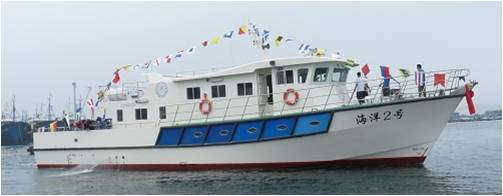Practical Workshops
Participants will take part in five practical workshops over four days. Each practical lasts for half a day (3h30). The 'Oral and written communication' workshop is mandatory. Successful applicants will participate in 4 of the following workshops:
Ø Mandatory:
- Oral and written communication
Oral and written communication in science
Ø Optional:
- Research cruise
Research cruise aboard the Tethys II (French research vessel) collecting chlorophyll/plankton samples, CTD data and other, chemical measurements
- Laboratory work
Laboratory work to examine and analyse cruise samples
- Gas exchange
Experimental work on gas and heat exchange across the air-sea boundary using micro meteorological techniques
- Carbon cycle modelling
Using carbon cycle models of different complexities to illustrate the use of numerical models for different time- and space scales.
- Atmospheric modelling
You will use web-based models mainly looking at atmospheric dispersion and atmospheric chemistry.
- Marine genomics
You will work on some real data sets that examine the genetic potentials and in situ activities of microorganisms in marine biogeochemical cycling.
Ø Oral and written communication
The oral and communication workshop will explain the basics of making a successful presentation. You will make a short presentation of your work to a small group and then discuss your strengths and weaknesses. The importance of body language will be discussed and tips on using PowerPoint will be provided. This will prepare you for a later presentation of your work to the whole School during your five minute presentations. The written communication workshop will involve a group discussion on the techniques for producing a successful poster, using your own poster as an example (see 'Student Duty' webpage within our 'Programme' drop-down menu above). Strategies for efficient scientific writing will also be discussed.
Ø Research cruise
You will spend half a day aboard the Xiamen University research vessel Ocean II to the Jiulong River estuary to the Xiamen Port where a salinity gradient profile will be sampled. You will collect water samples at one conductivity temperature depth (CTD) station using a rosette and Niskin bottles. You will perform on board dissolved oxygen measurements. You will also deploy nets to sample phytoplankton and zooplankton over a given depth interval. CTD and basic meteorological measurements will be made. Back at MEL you will measure collected samples for salinity and silicates and will examine under the microscopes the collected plankton.  This practical will give you an idea of the practicalities of making basic measurements at sea.
This practical will give you an idea of the practicalities of making basic measurements at sea.
Ø Laboratory work
Back at MEL, you will use microscopes to explore the wide range of marine particles from large organic aggregates to tiny phytoplankton. You will also identify some phytoplankton and zoo-plankton species. The filtrate from several depth profiles will be analysed for chlorophyll. You will also analyse water samples for salinity and nutrients. The results from all of the cruises will be synthesised into a coherent picture of the coastal sea's biogeochemistry.
Ø Gas exchange
You will conduct a laboratory experiment to measure the rate at which several trace gases transfer across a sea water-air interface. In addition, you will conduct a numerical exercise illustrating several properties of the carbonate system of seawater. Computer required for Library session: Excel and CO2calc.
Ø Carbon cycle modelling
Using carbon cycle models of different complexities to illustrate the use of numerical models for different time- and space scales.
Ø Atmospheric modelling
The modelling practical will use web-based models mainly looking at atmospheric dispersion and atmospheric chemistry. The exercises will be offered at different levels so that students new to atmospheric modelling as well as “specialists” will be able to benefit from them. Computer required.
Ø Genomics
You will work on some real data sets that examine the genetic potentials and in situ activities of microorganisms in marine biogeochemical cycling. Qualitative and quantitative comparison will be made with data acquired through various techniques. In addition, you will explore and decipher possible biogeochemical functions of some unknown microorganisms from (meta) genome(s). Computer required: Excel, CO2calc & IrfanView.